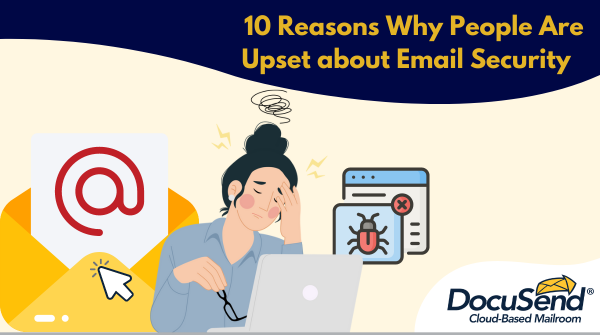10 Reasons Why People Are Upset about Email Security

What should you do if you get lots of e-mails saying, “What's up, Doc? What's up, Doc?” Check for Bugs in your system. (Sorry, couldn’t resist!)
The Email Predicament
Moving to a serious zone, in the May 2018 issue of The Atlantic , an insightful article was featured.* It drew inspiration from a collective of European security researchers and provided crucial information for businesses of all sizes that deal with electronic distribution of sensitive documents or are considering it. In their study, they reached the conclusion that email security is not only challenging but may also be impractical to achieve.
The article from The Atlantic serves as evidence of the apprehension shared by consumers and companies when it comes to using email for exchanging sensitive information. Furthermore, speaking about security concerns, individuals are becoming more and more tired of the additional challenges created by email and the frustration that arises when they lack sufficient control over it. This article prompted me to read other ones on this topic, and the more I delved into it, the more they reaffirmed what I've been noticing for quite some time now. Based on the insights gathered from these articles, I present ten of the main reasons why people experience frustration with email.
- 1. Each day, individuals check their email an average of 77 times, with some reaching as high as 373 times. As the number of emails individuals need to deal with increases, their assessed productivity declines.1
- 2. “There is a notable quote that resonates with the email problem: "An email inbox is a reservoir of your own time managed by other people."2 It is common for many of us to accumulate thousands of unread emails, and the number continues to grow daily. The result is that our productivity is affected by things beyond our control.
- 3. The majority of internet research shows that the act of writing or sending emails generates significantly less stress compared to the stress caused by receiving them. Food for thought when sending an invoice to a valued client next time!
- 4. “Electronic mail as we know it is drowning in spam, forged phishing emails, and other scams and hacks. It’s going to get worse before it gets better.”3
- 5. OpenPGP has been the encryption program for enhancing email security with the broadest usage. Since 1991, this technology has been ensuring privacy and authentication for email data communication and protecting computer systems from potential hacking attempts. PGP stands for “Pretty Good Privacy.” Do you want “pretty good” to be a description of the technology safeguarding your computer systems from hacking?
- 6. Attachments in emails serve as extensions of email capabilities, created through MIME (Multipurpose Internet Mail Extensions), and are one more significant vulnerability for computer security. When you click on the attachment with the intention of viewing it, little do you know that it has been designed to run code, allowing it to take control of your computer. By innocently clicking on such an attachment, you might give control of your computer to hackers and expose yourself to potential security breaches.4
- 7. In 1998 the movie You’ve Got Mail was released, and it became the subject of Britney Spears’ song “Email My Heart,” which came out in 1999. It was a time when people loved email. Until that changed. In 2016, email's narrative shifted from being a theme of love songs and romantic comedies to becoming a central topic of discussions concerning digital overload and the lack of work-life balance. It was depicted in dark colors using the words “avalanche,” “drowning,” and “tyranny.”5
- 8. “Email is just too many things to too many people, all at once, everywhere.”6 It’s ubiquitous, and since technology rarely entirely disappears, “We can’t roll back what email has become."7
- 9. “Spam, malware, phishing, ransomware—it's the stuff savvy cybercriminals use to steal your identity and money and hold your high-tech life hostage.”8
- 10. “Email isn't secure because it was never meant to be the center of our digital lives. It was developed when the internet was a much smaller place and meant to standardize simple store-and-forward messaging between people using different kinds of computers. Email was all transferred completely in the open—everything was readable by anyone who could watch network traffic or access accounts (originally not even passwords were encrypted). Amazingly, email sent using those wide-open methods still (mostly) works.”9
Give Clients a Choice
For these reasons and more, there is a shift occurring toward more secure methods of distribution, driven by consumers’ preferences and advancements in print-to-mail technology.
- Dr. Larry Ponemon, publisher of the Ponemon Institute’s Most Trusted Companies, said: “Companies that rank high in consumer trust have a strong orientation to respecting their customers and providing the best possible customer service.” In national surveys, approximately one out of every three respondents indicated that they returned to paper delivery after initially attempting to eliminate it in favor of receiving documents only by electronic means. Over time, providing people with options can positively impact key aspects, such as fostering loyalty and reducing the number of accounts cancelled by the customer.10
- The National Consumer Law Center is advocating for free availability of physical statements and opposing the default push of electronic billing on customers who would still like to receive their statements on paper. According to the NCLC, there is a digital divide between individuals with broadband access, electronic devices, and computer literacy and those without these things. Such a divide is one of their primary arguments against pressuring customers to give up paper invoicing. The report states that a considerable portion of households with incomes less than $20,000 don’t have home broadband access. It highlights that even those who have access may encounter challenges due to older computers, slow connection speed, the absence of a printer, or the expensive ink for printing out statements.11
- A Federal Trade Commission (FTC) publication reveals that cyber scammers are employing an old phishing tactic by impersonating a well-known tech company. They send deceptive emails containing fake invoices, falsely claiming that you have made recent purchases of music or apps from their platform.12 You did not purchase anything, and you feel frustrated, but there seems to be a solution: If you did not authorize the purchase, the email urges you to click on a link. Caution! Do not click on that link! It’s just a trap, another phishing attempt involving deceptive emails or texts, or fraudulent websites, imitating the websites of real companies to make you unintentionally give access to your sensitive information and passwords. Hackers also use phishing emails as a means to gain access to your device or network. Once inside, they can install harmful programs, such as ransomware, which have the potential to lock you out of essential files on your computer.
- Approximately 97 percent of paper invoices and statements are opened by the recipients, and they are quickly read.13
- An online survey of more than 2,600 people by the nonprofit group Consumer Action found that a majority preferred paper for: medical bills (74 percent), property taxes (71 percent), motor vehicle renewals (69 percent), insurance (66 percent), utility bills (63 percent), credit card statements (61 percent), and phone bills (56 percent).14
What is the best decision for the business owner? Just give your customers what they need.
Being aware of important issues such as these, businesses can gain insights that might help them in making more informed decisions. However, the complexities surrounding email usage in the current landscape are vast and multifaceted, and it’s impossible to review them all in one article. But what we can do is provide you with clear guidance on enhancing your business mailing process if your clients prefer the good old paper invoices, reliable and secure. And not only invoices but also other important documents of all kinds. There is a service that will reduce your internal mailing expenses at least by half. The process is quite simple: It only takes less than 3 minutes to upload your PDF files to the DocuSend online mailroom, and your communications are printed out by a specialized service, automatically inserted into envelopes with the help of high-speed equipment and software, and passed to the USPS within two business days. There is absolutely no difference whether there are a few invoices or 10,000: They will have discounted bulk prices per envelope and will be sent within two business days. DocuSend is a pay-as-you-go app, so there aren’t any required minimums or contracts. Instead, there is a boatload of helpful features to boost your mailing efficiency: perforated paper, duplex printing, color printing, adding a return envelope or generic flyers to every document, various distribution options, a free report portal that tracks all your mailing activity for the last 6 month, a mail tracking service, and NCOA updates of your address list at no extra cost.
Give it a try once and you'll discover how comfy and budget-friendly it is. It’s faster than buying a stamp!
I hope this article provided you with some useful information. As usual, we welcome your comments, because your experiences may be valuable to other small businesses.
* The Atlantic -> Email Is Dangerous.
1. Gloria Mark, University of California, Irvine, 2. Sean Rose, @sean_a_rose, 3. “Email Is Dangerous,” The Atlantic, 4. Ibid. 5. “The Triumph of Email,” The Atlantic 6. “How Email Became the Most Reviled Communication Experience Ever,” Co. Design, 7. Ibid. 8. “Watch out for these spam emails,” USA Today, 9. “Here’s why your email is insecure and likely to stay that way,” Digital Trends 10. Annual List of Most Trusted U.S. Companies, 2008-2014, Ponemon Institute, 11. “Why Old-Fashioned Paper Statements May Be a Better Choice,” MoneyTalksNews, 12. “Phishers send fake invoices,” FTCs February 2018, 13. “Insights into Transactional Communications Market,” Output Links, 14. Ibid.

